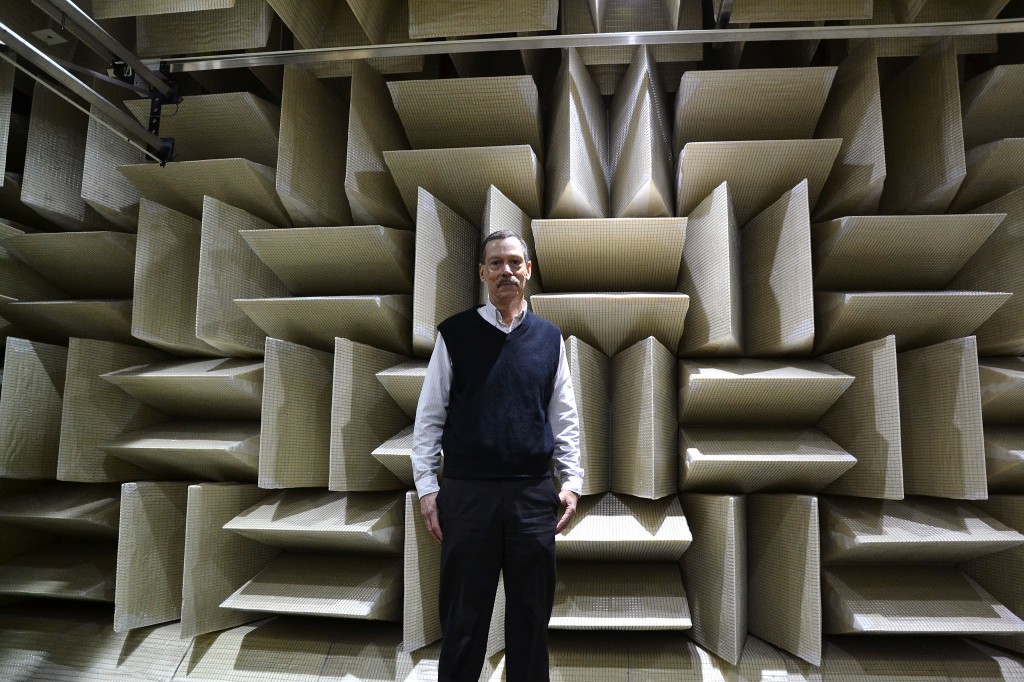
To improve the acoustics in everyday electronic devices, a Binghamton University professor is studying vibrations to help better understand and control sound itself.
Ronald Miles, distinguished professor of mechanical engineering and associate dean of research at the Watson School of Engineering, and his team of five graduate students study acoustics, a branch of physics concerned with properties of sound, by using custom-made microphones in an anechoic chamber in the Innovative Technologies Complex (ITC).
Meaning “free from echo,” an anechoic chamber is a room designed to block out sound from the outside and absorb sound on the inside so that the microphones can collect the most accurate measurements.
“It is very important to have a quiet place where there are no echoes from the walls when you want to accurately characterize the performance of microphones,” Miles said.
The anechoic chamber itself is about 13 by 15 feet and is covered in long, cream-colored triangular prisms composed of metal and fiberglass coated with fabric. This covers all four walls, the ceiling and floor. At the center of the chamber lies a speaker, and hanging from the ceiling is the microphone that collects and sends data to Miles and his team for analysis.
In the chamber, Miles’ team uses BU’s five-axis microphone positioning system to measure sound and reconstruct 3-D images of pure sound that is generated in the anechoic chamber with a loudspeaker.
The chamber stands on springs, which completely isolates it from the rest of the building.
“Inside the anechoic chamber, the walls and ceiling act as if they aren’t there at all,” said Jonathan Walsh, a third year doctoral candidate studying mechanical engineering who works with Miles. “As if the room stretches out into infinity in all directions. We call that situation ‘free space’ with no reflections or outside noise.”
This is important because it eliminates unwanted noise, including vibrations, that will affect the acoustic measurements in the chamber. Brenno Varanda, a fourth year doctoral candidate studying mechanical engineering, described the chamber as an ideal environment for noise sensitivity tests because of its isolation.
“It is the closest somebody can get to an ideal acoustic test in the Northeast,” he said.
According to Miles, the chamber was purchased from Eckel Industries as a tool to conduct research as accurately as possible. From there, he and his team designed a soundproof enclosure around it and Eckel measured it to be one of the quietest chambers ever built.
The chamber and enclosure cost about $1 million, funded by money used to build the Engineering and Science building. Miles’ research focuses on how to detect sound with portable electronic devices that rely on very small acoustic sensors.
“This is important for hearing aid users since it can help them understand speech when they are in noisy places,” Miles said. “A directional microphone on the hearing aid gets rid of the competing sounds and enables them to better understand the person they are talking to.”
According to Varanda, people are naturally able to focus their hearing to one sound even when other sounds are around them, known as directional hearing. Many hearing aids cannot focus on specific sounds, so all sounds become amplified equally.
“The ability for a hearing aid to act as a normal functioning hearing system, that will focus sound coming from the direction you wish, is a must in noisy environments,” Varanda said.
To Varanda, the research possibilities excited him every time he used the room.
“I love to study acoustics because it is a challenging, rewarding and tangible subject,” he said. “There is never a day that I can say I know everything about it; there is always something new to learn and new a toy to play with.”


